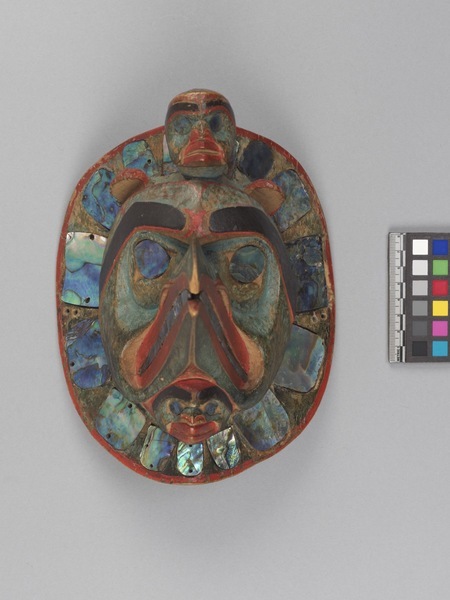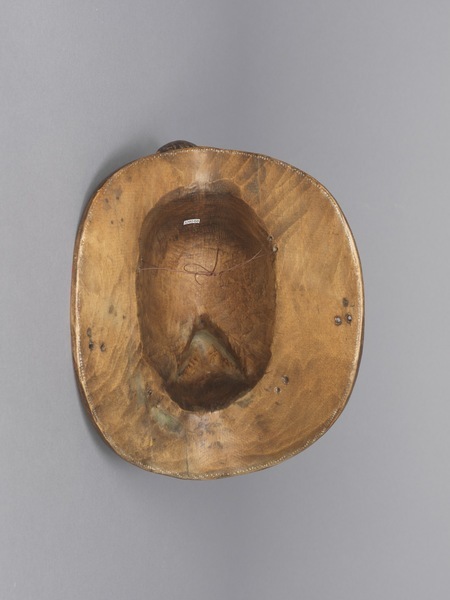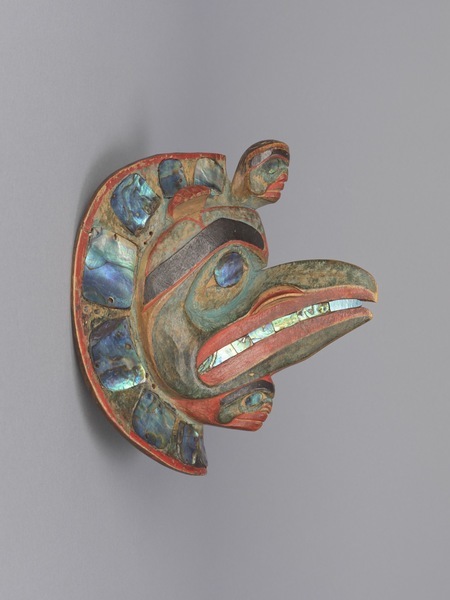Frontlet Item Number: 3260/68 from the MOA: University of British Columbia



Description
Carved and painted wooden frontlet with abalone inlay all around the sides and as eyes in the three faces. Roughly circular in shape; main, central face is a bird with a large beak projecting outward. Above is a small three-dimensional head projecting outward; there is another small round face below the beak. Each figure's eyes are abalone disks. A flat rim surrounds the whole frontlet, inlaid with numerous abalone pieces in various shapes, primarily rectangular or rounded squares. Many of the inlays have holes drilled through both sides. Brown plastic wire is tied at the back through four of the side holes; there are six holes drilled through on each side. (There is an epoxy resin filled area at the back, from an old repair).
History Of Use
Among the Kwakwa̠ka̠’wakw, a frontlet or forehead mask like this is known as a pak̠iwe’. Its name changes to ya̠x̠wiwe’ (“dancing on the forehead”) when it is part of the full headdress — including a cylindrical crown with sea-lion whiskers at the top and an ermine-skin trailer — that is featured in the T’ła’sa̠la or Peace Dances (also known as the Dluwa̠lax̠a or Returned-from-Heaven Dances). Abalone shell has been inlaid as the eyes, and on the beak and corona; many of the pieces had holes drilled through them, indicating their possible previous use as ornaments sewn onto button blankets or other regalia.
Iconographic Meaning
This frontlet represents a raven, with small human faces above and below; the two expressive faces, together with the human-like characteristics of the bird itself -- heavy black eyebrows, red “lips” that define the beak -- hint at the supernatural raven’s ability to transform between human and avian form.
Narrative
Historically, marriages are known to have been arranged by the Kwakwaka’wakw in order to obtain prestigious ceremonial rights owned by the Heiltsuk. Although this pakiwe’ was probably carved by a Heiltsuk artist, as indicated by the shape of the eye orbs, cheek planes, and other central-coast characteristics of style, it has a history of ownership and use among the Kwakwaka’wakw people. There is a photograph taken in Alert Bay of Chief Thomas Hunt wearing this frontlet, attached to an ermine headdress. The frontlet is thought to have been owned at that time by his sister, Agnes (Hunt) Cranmer. There are four other chiefs in the photograph, which is presumed to have been taken at the raising of a memorial pole for Chief Mungo Martin in September 1970. The frontlet is thought to be of Heiltsuk origin.
Item History
- Made in British Columbia, Canada between 1840 and 1860
- Owned by Hunt Family
- Owned by Elspeth McConnell before August 12, 2017
- Received from Elspeth McConnell (Donor) on August 12, 2017
What
- Name
- Frontlet
- Identification Number
- 3260/68
- Type of Item
- frontlet
- Material
- maple wood ?, abalone shell and paint
- Overall
- height 22.0 cm, width 17.5 cm, depth 17.0 cm
Who
- Culture
- Kwakwaka'wakw
- Previous Owner
- Hunt Family and Elspeth McConnell
- Received from
- Elspeth McConnell (Donor)
Where
- Holding Institution
- MOA: University of British Columbia
- Made in
- British Columbia, Canada
When
- Creation Date
- between 1840 and 1860
- Ownership Date
- before August 12, 2017
- Acquisition Date
- on August 12, 2017
Other
- Condition
- good
- Accession Number
- 3260/0068